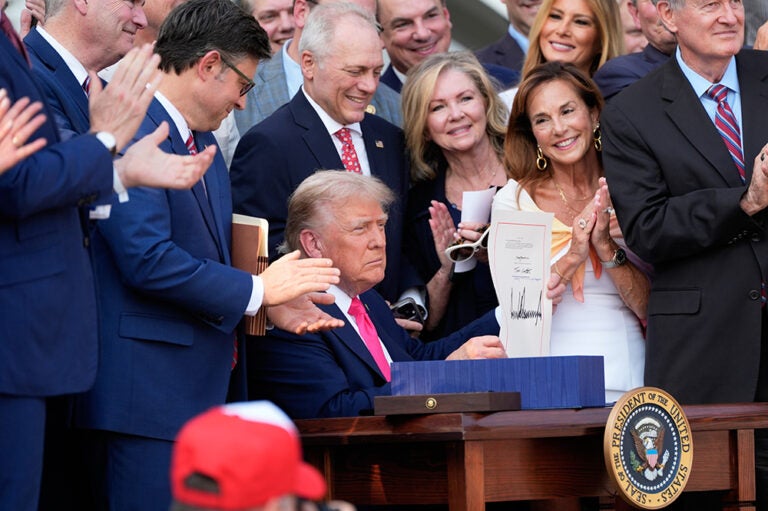Federal spending for veterans has increased sharply in the past two decades as scores of veterans returned home from extended wars in Iraq and Afghanistan, many with significant needs resulting from their service. In 2024, spending for programs that support veterans totaled $326 billion, or about 5 percent of all federal spending. In addition, lawmakers enacted the PACT Act in August 2022 to enhance health and disability benefits for veterans exposed to toxic substances during active duty, which will boost spending significantly.
Ensuring our veterans receive the benefits they have earned and deserve is a critical national priority. To shed light on this important topic, this piece examines spending on veterans within the budget and outlines the factors that have pushed it higher in recent years.
How Does the Department of Veterans Affairs Allocate Its Resources?
The Department of Veterans Affairs (VA) is the primary steward of federal support for veterans. In general, a veteran is a person who served in the military and who was discharged (retired) in conditions other than dishonorable. The vast majority of VA programs provide income security and healthcare to eligible veterans and their families.
Income Security Programs for Veterans
Spending on income security programs for veterans and their survivors totaled $161 billion in 2024. The majority of such spending, about $152 billion, was compensation for service-connected disabilities.
Veterans Disability Compensation: Veterans with a service-connected disability (a physical or mental injury or condition that was “incurred or aggravated” in the line of military duty) are eligible for monthly support. Payments grow in step with disability ratings, and benefits are adjusted for the number of dependents if a veteran has a 30 percent or higher disability rating. According to the Veteran Benefits Administration’s Annual Benefits Report, 6 million veterans received an average of $25,446 in disability compensation in 2024.
In addition, the VA administers three pension programs:
Veterans Pension: To be eligible, a veteran must meet criteria related to period of service and military discharge status, income and net worth, and disability or age. In 2024, the Veterans Pension program paid an average annual benefit of $14,486 to 137,817 beneficiaries.
Survivors Pension: Most survivors are eligible for this benefit if the deceased veteran met the requirements for the Veterans Pension program and the survivor meets the same net worth requirement. Survivors include spouses and children of deceased veterans. In 2024, 98,155 survivors received an average annual benefit of $11,212.
Medal of Honor Pension: This program pays a monthly benefit for life to 63 Medal of Honor recipients. The stipend increases each year to reflect the same cost-of-living adjustments as Social Security; the monthly stipend in 2025 is $1,713, equivalent to nearly $20,555 per year.
Healthcare Spending on Veterans
The VA is a direct provider of healthcare and health-related services for veterans through an integrated healthcare system spanning 1,380 sites of care, including hospitals, community living centers, healthcare centers, community-based outpatient clinics, other outpatient service sites, and dialysis centers. Medical benefits include hospital services, prescriptions, medical equipment, and prosthetic devices. To be eligible, veterans must meet minimum service requirements, though exceptions are made for veterans discharged due to service-connected disabilities.
Upon determining eligibility, the VA enrolls veterans into one of eight priority groups based on various factors including severity of disabilities, income, and combat veteran status (among others). The system helps ensure that the veterans most in need receive care quickly. Some priority groups are required to pay co-payments for certain benefits, but none pay premiums, deductibles, or coinsurance for care. In addition to healthcare services, the VA is statutorily required to conduct medical research, train healthcare professionals, as well as support the Departments of Defense and Health and Human Services as necessary.
How Has VA Spending Changed Over Time?
Spending for the VA has grown substantially in the past two decades, particularly as veterans returned home from service in Iraq and Afghanistan. In 2024, total spending included $192 billion in programs governed by permanent law (known as mandatory spending) and $134 billion provided through the appropriation process (known as discretionary spending). Programs related to income security are primarily mandatory spending, while healthcare and related services have been funded through appropriations (although recent legislation made some healthcare spending mandatory).
Income Security Spending Has Grown as the Veteran Population Ages
The growth in spending on income security for veterans is due to an aging population, which increases the number of eligible beneficiaries. Other factors driving up spending stem from cost-of-living adjustments and changes to benefit payments, including within legislation enacted in response to COVID-19.
According to the Congressional Budget Office, both the number of veterans receiving disability benefits and the average real amount of those payments have increased. For example, while the total population of living veterans declined from 26.4 million in 2000 to 18.3 million in 2023, the number of beneficiaries rose from 2.3 million to 6 million. Over that period, inflation-adjusted payments for veterans also rose — from $11,900 in 2000 to $25,446 in 2024.
Healthcare Spending Has Grown to Meet Increased Demand from Veterans
Healthcare spending has grown to meet an increasing demand for services. In the past two decades, the number of veterans using VA healthcare has grown, as has the number categorized as having severe disabilities, which raises the demand for healthcare and other services. For example, in 2018, the latest year for which data is available, there were 6.1 million veteran patients using VA healthcare, nearly double the number enrolled in the year 2000.
In 2018, 2.2 million veterans were in priority group 1, about five times the number in the year 2000. That growth is largely attributable to post-9/11 veterans, which have higher disability rates (41 percent) relative to all veterans (25 percent overall). Experts note that advances in battlefield medicine and rapid evacuations have resulted in more veterans surviving severe wounds. The VA reports that average per patient health expenditures for disabled veterans, including priority groups 1–4, were $13,500 in 2018 or nearly three times the average spending for veterans in other groups combined.
Recent Expansion of Benefits
In August 2022, the President signed into law the Honoring our PACT Act of 2022. The law increased disability compensation and expanded health care services for a large group of veterans who were exposed to toxic substances or who served in certain locations during their military service. It also increased the number of veterans without service-connected disabilities who can receive health care from the Department of Veterans Affairs. Furthermore, the act reclassified some discretionary spending under current law as mandatory spending. Overall, the Congressional Budget Office estimates that the act would increase spending by nearly $300 billion between 2022 and 2031.
Looking Ahead
A key part of honoring our veterans’ service and ensuring they receive the benefits they have earned and deserve is understanding how spending in this area fits into the federal budget. Indeed, support for veterans should be acknowledged and factored into decisions about our nation’s military activities to ensure that lawmakers and the public have a full view of the costs. As veterans programs, including income security and healthcare support, continue to grow in size, it will be critically important that lawmakers recognize and account for these growing costs in order to ensure that they are consistent with the fiscal capacity of the federal budget in the long run.
Image credit: Chip Somodevilla/Getty Images
Further Reading
Budget Basics: Unemployment Insurance Explained
The Unemployment Insurance program is a key counter-cyclical tool to help stabilize the economy and speed recovery during downturns or crises.
How Did the One Big Beautiful Bill Act Affect Federal Spending?
Overall, the OBBBA adds significantly to the nation’s debt, but the act contains net spending cuts that lessen that impact.
What Is the Disaster Relief Fund?
Natural disasters are becoming increasingly frequent, endangering lives and extracting a significant fiscal and economic cost.


